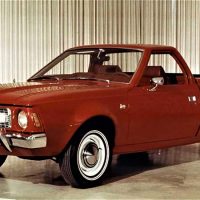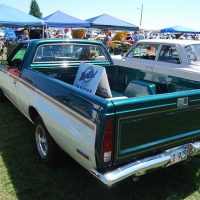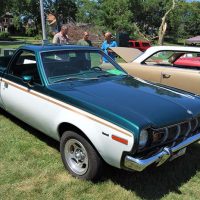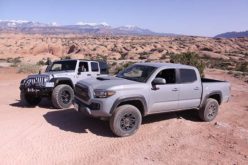The rootin’ tootin’ Jeep/AMC Cowboy Pickup Prototypes
By John Gunnell

At the 2011 World Meet show the owners of the green and white Cowboy prototype were listed as Danna and Eric Thompson, Jim and David Alexander and Ed Bricknell.
The Jeep/AMC Cowboy concept trucks were a reaction to the compact-sized pickups from Japan that were starting to invade the American light truck segment. Three Cowboy concept trucks were actually built and each one was a little different. Only the first one—red in colour—carried Jeep badges. The other two were envisioned as AMC products.
AMC was American Motors Corp., the company that resulted from the merger of Nash and Hudson in 1954. The cars themselves really weren’t popularly known as AMCs until the early 1960s. However, the company name was American Motors from 1954 on. The automaker had luck selling compact cars in the late-1950s when the American economy suffered a recession. But, by 1960, things were bouncing back to normal and demand for compact economy cars began to dwindle. AMC needed new ideas.
By 1969, AMC bought Jeep, spending tons of money for that iconic brand, as well as some $40 million to make the Hornet car. To get a return on its investments, AMC hoped to turn the Jeep nameplate and the Hornet model into money-making products. The Cowboy pickup was originally viewed as a way to link the Jeep name to the Hornet.

The 1971 AMC Cowboy pickup has a separate cab and cargo box and a conventional drop down tailgate with no manufacturer’s name stamped on it.
Basically, AMC sent a Hornet to the Jeep styling studio and asked Jeep designers to convert it into a truck that would compete with the imports in size, rival the Chevy El Camino in looks and cost less than both of them. The red Cowboy prototype wore the Jeep name. A green and white Cowboy was made from a Hornet SC 360 with a 360-cid V8. The third Cowboy was yellow and had a six-cylinder engine and a Gremlin front end.
It is believed that the red “Jeep” version came first. Unlike all Jeeps being built at that time, the car-based Cowboy was not a 4-wheel-drive vehicle. In fact, AMC grew concerned about the Jeep badging on a two-wheel-drive car and called the other two prototypes AMC Cowboys instead of Jeep Cowboys. AMC later developed a four-wheel-drive system for the Eagle, but in 1971 the cost to do that was not in the budget.
In fact, AMC even struggled with the cost of making a single-unit pickup body like the El Camino used. It was thought that such a body would be a necessity to give the Cowboy neat lines. But AMC product planner Jim Alexander addressed the problem. A former designer for automotive and non-automotive firms, Alexander suggested that a good-looking pickup could be created using traditional separate cab and box construction.
Alexander was correct. All three Cowboys had a separate cab and cargo box and all three turned out to be winners in the appearance department. As for supporting a cargo box on a unit-body vehicle platform, Alexander came up with the idea of using what was essentially a rear stub-frame to carry the cargo box. An AMC Ambassador gas tank was attached amidships with the spare tire mounted under the back half of the cargo box.
The green and white Cowboy had green front bucket seats, a floor-mounted stick shift, a radio and air conditioning. There was an SC 360 badge on the glovebox door. The car’s 360-cid V8 also wound up with aftermarket Edelbrock high-performance cylinder heads, but they were probably added some time after AMC sold the truck to its designer.
The reason the Cowboy never went into production was that AMC felt a Hornet Hatchback had a better shot at success in the marketplace. That body style was added to the Hornet model lineup in 1973 and none of the three Cowboy prototypes was ever manufactured as a mass-production model. Considering how pickups and other light trucks got very popular from the 1970s on, AMC probably made a mistake. The company was always kind of like that, it had a few big hits, but probably as many bad decisions.

The floor-mounted shifter controls gear changes of the three-speed manual transmission. It has wind-up windows and dual outside rearview mirrors
According to Collectible Automobile (October 1994), Jim Alexander bought the green and white Cowboy from AMC. Then, he and his son changed the early front end to AMC’s 1975 Hornet style grille and sheet metal. They later sold the car to Jim’s nephew. When Collectible Automobile featured the car, Edward T. Bicknell of Kansas owned it.
“The green AMC Cowboy wound up with Jim Alexander’s nephew years ago,” according to AMC expert Mike Spangler, of Jefferson, Wis. “That one was the cowboy based on the Hornet SC 360,” Spangler pointed out to Trucks Plus. “There was another one based on a Gremlin front end which is owned by Brian Moyer of Pennsylvania. I think it is under restoration. Brian also owns the Gremlin Voyager Prototype GREM BIN and the Gremlin prototype Gremlin XP, as well as a right-hand drive Australian-built Gremlin.”



















